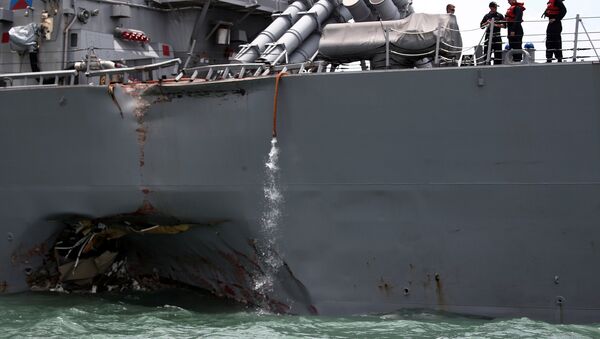WASHINGTON (Sputnik) — US Navy investigations have found that the collisions involving the warships Fitzgerald and the John S. McCain were both avoidable, Chief of Naval Operations Adm. John Richardson said on Wednesday, following top officers dismissals' in early October.
READ MORE: US Navy Fires USS McCain's Top Officers Following Deadly, ‘Preventable' Crash
"Both of these accidents were preventable and the respective investigations found multiple failures by watchstanders that contributed to the incidents," Richardson said after the publication of a report on the accidents. "We must do better."
Collision between Fitzgerald and Crystal
The Navy detailed in the report the events and actions that led to the collision of the Fitzgerald and ACX Crystal off the coast of Japan on June 17 and the collision of John S. McCain and the merchant vessel Alnic MC on August 21.
The collision between the Fitzgerald and Crystal was avoidable and resulted from an accumulation of smaller errors over time, ultimately resulting in "a lack of adherence to sound navigational practices."
"Specifically, Fitzgerald's watch teams disregarded established norms of basic contact management and, more importantly, leadership failed to adhere to well-established protocols put in place to prevent collisions."
John S. McCain and Alnic MC Collision
Investigators hurled their harshest criticism at the commanding officer, executive officer and the bridge watch team of the John S. McCain, adding that they did not know how to operate the ship control console during an emergency.
"The collision between John S. McCain and Alnic MC was also avoidable and resulted primarily from complacency, over-confidence and lack of procedural compliance," according to the Navy's press release.
The Navy identified as a major contributing factor to the collision the sub-standard level of knowledge regarding the operation of the ship control console.
"In particular, McCain's commanding officer disregarded recommendations from his executive officer, navigator and senior watch officer to set sea and anchor watch teams in a timely fashion to ensure the safe and effective operation of the ship."
The Navy concluded that with regard to procedures, no one on the bridge watch team, including the commanding officer and executive officer, were properly trained on how to correctly operate the ship control console during a steering casualty.

